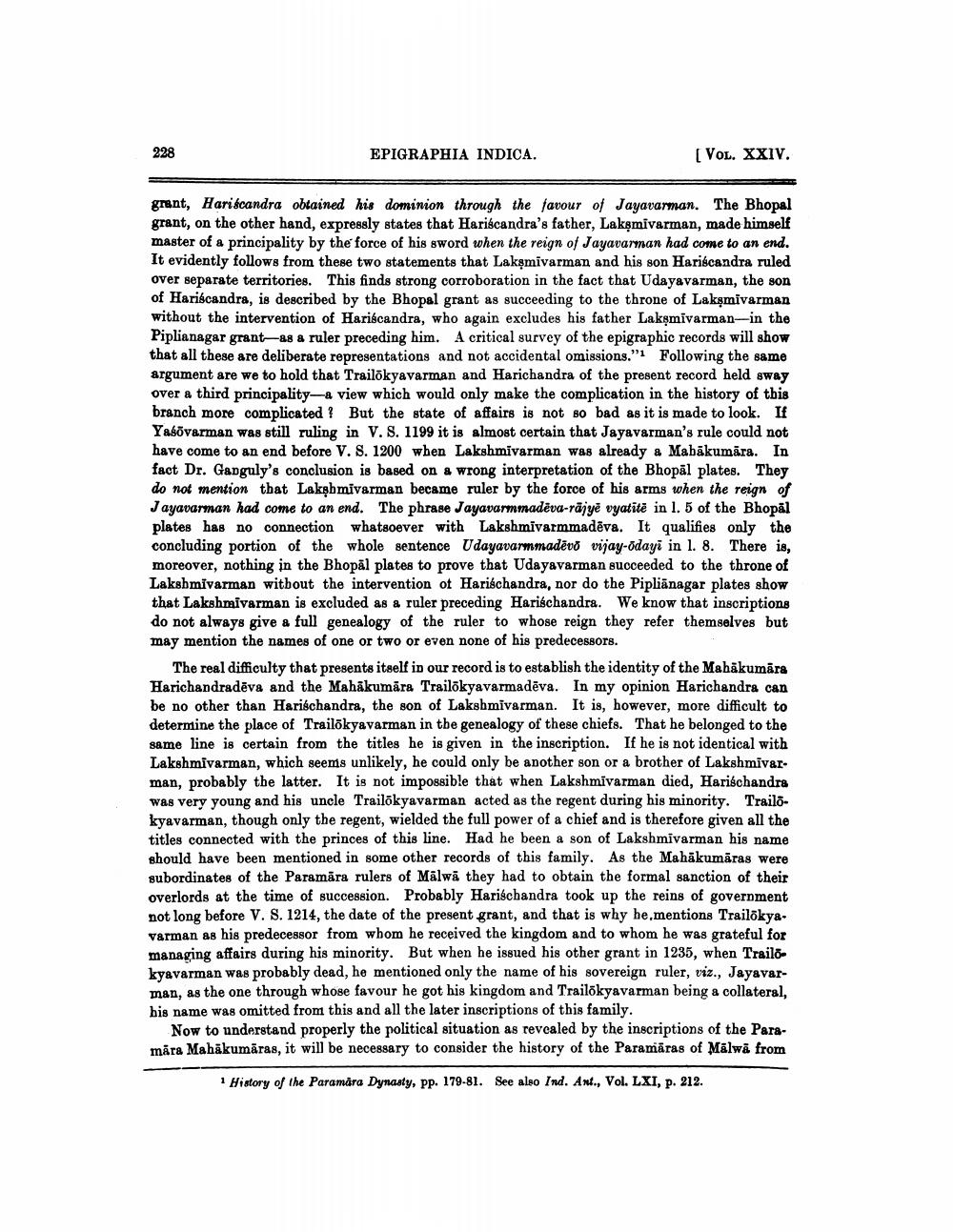________________
228
EPIGRAPHIA INDICA.
[VOL. XXIV.
grant, Hariscandra obtained his dominion through the favour of Jayavarman. The Bhopal grant, on the other hand, expressly states that Hariscandra's father, Lakşmivarman, made himself master of a principality by the force of his sword when the reign of Jayavarman had come to an end. It evidently follows from these two statements that Lakşmivarman and his son Hariscandra ruled over separate territories. This finds strong corroboration in the fact that Udayavarman, the son of Hariscandra, is described by the Bhopal grant as succeeding to the throne of Lakşmivarman without the intervention of Hariscandra, who again excludes his father Lakşmivarman--in the Piplianagar grant-88 8 ruler preceding him. A critical survey of the epigraphic records will show that all these are deliberate representations and not accidental omissions."1 Following the same argument are we to hold that Trailokyavarman and Harichandra of the present record held sway over a third principality- view which would only make the complication in the history of this branch more complicated ? But the state of affairs is not so bad as it is made to look. If Yaśõvarman was still ruling in V. S. 1199 it is almost certain that Jayavarman's rule could not have come to an end before V. S. 1200 when Lakshmivarman was already a Mabākumāra. In fact Dr. Ganguly's conclusion is based on a wrong interpretation of the Bhopal plates. They do not mention that Lakşmivarman became ruler by the force of his arms when the reign of Jayavarman had come to an end. The phrase Jayavarmmadēva-rajye vyatītē in l. 5 of the Bhopal plates has no connection whatsoever with Lakshmivarmmadēva. It qualifies only the concluding portion of the whole sentence Udayavarmmadēvo vijay-odayi in l. 8. There is, moreover, nothing in the Bhopāl plates to prove that Udayavarman succeeded to the throne of Lakshmivarman without the intervention of Harischandra, nor do the Pipliānagar plates show that Lakshmivarman is excluded as a ruler preceding Harischandra. We know that inscriptions do not always give a full genealogy of the ruler to whose reign they refer themselves but may mention the names of one or two or even none of his predecessors.
The real difficulty that presents itself in our record is to establish the identity of the Mahākumāra Harichandradēva and the Mahākumāra Trailökyavarmadēva. In my opinion Harichandra can be no other than Harischandra, the son of Lakshmivarman. It is, however, more difficult to determine the place of Trailökyavarman in the genealogy of these chiefs. That he belonged to the same line is certain from the titles he is given in the inscription. If he is not identical with Lakshmivarman, which seems unlikely, he could only be another son or a brother of Lakshmivar. man, probably the latter. It is not impossible that when Lakshmivarman died, Hariéchandra was very young and his uncle Trailokyavarman acted as the regent during his minority. Trailokyavarman, though only the regent, wielded the full power of a chief and is therefore given all the titles connected with the princes of this line. Had he been a son of Lakshmivarman his name should have been mentioned in some other records of this family. As the Mahākumāras were subordinates of the Paramāra rulers of Mālwā they had to obtain the formal sanction of their overlords at the time of succession. Probably Harischandra took up the reins of government not long before V. S. 1214, the date of the present grant, and that is why he mentions Trailokya. Varman as his predecessor from whom he received the kingdom and to whom he was grateful for managing affairs during his minority. But when he issued his other grant in 1235, when Trailo kyavarman was probably dead, he mentioned only the name of his sovereign ruler, viz., Jayavarman, as the one through whose favour he got his kingdom and Trailökyavarman being a collateral, his name was omitted from this and all the later inscriptions of this family.
Now to understand properly the political situation as revealed by the inscriptions of the Paramira Mahākumāras, it will be necessary to consider the history of the Paramaras of Mālwă from
1 History of the Paramara Dynasty, PP. 179-81. See also Ind. Ant., Vol. LXI, p. 212.




